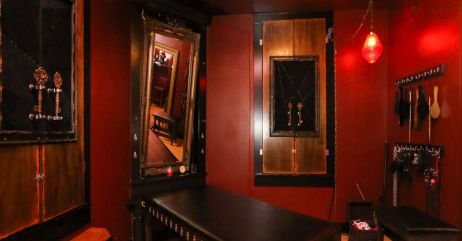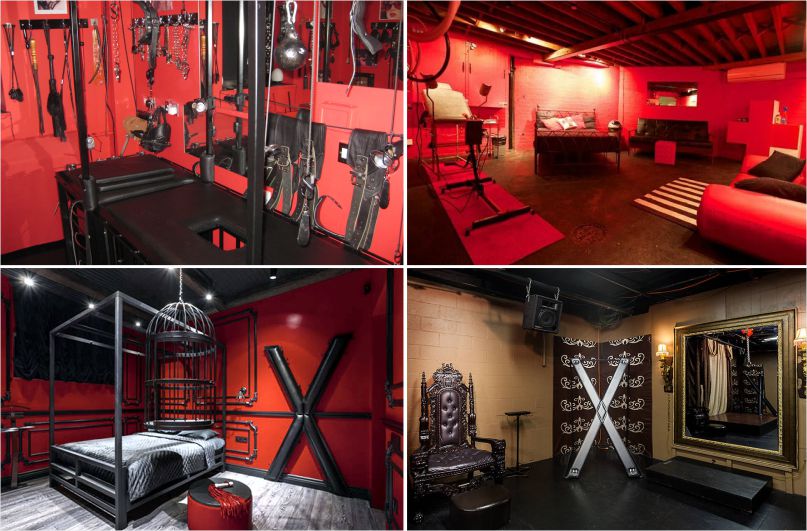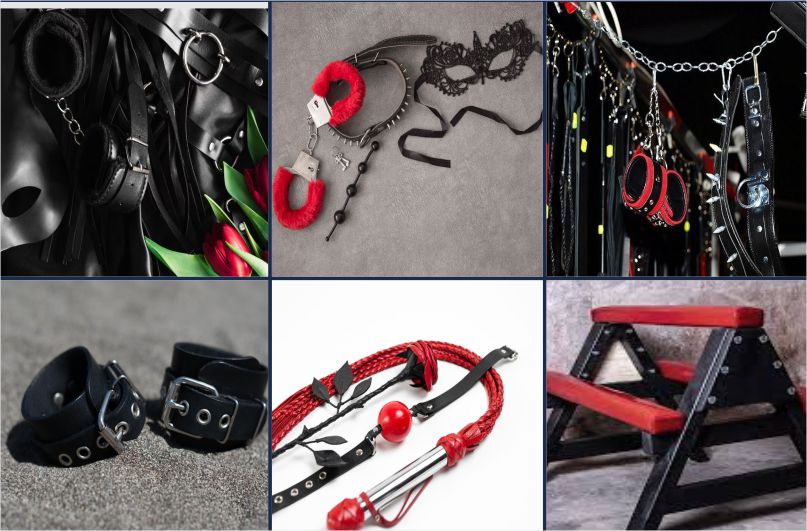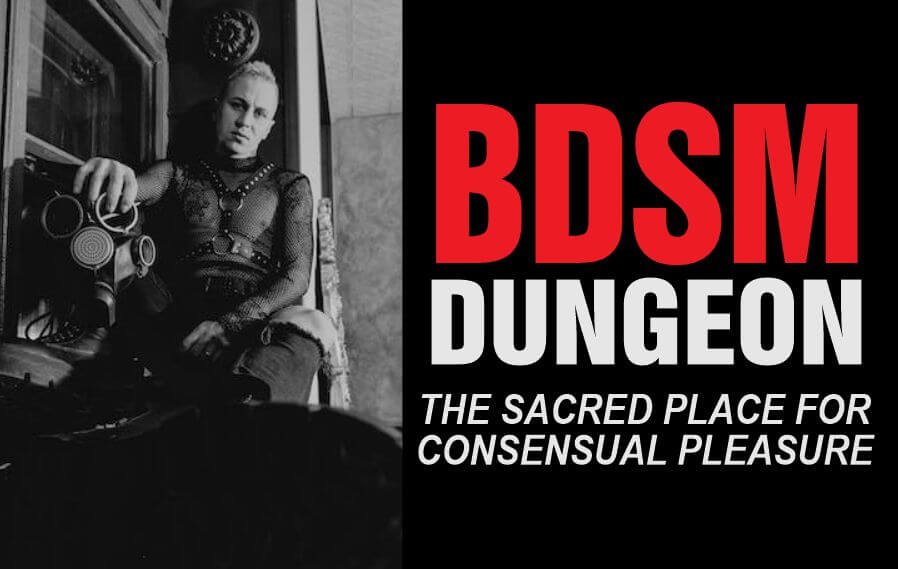Last updated on April 15th, 2025 at 09:42 pm
Step inside the world of BDSM dungeons, private, public, and professional spaces designed for consensual power exchange. Learn about their features, rules, and safety measures to ensure a secure and thrilling experience. Explore what makes a dungeon the right fit for your kinks.
A BDSM dungeon is more than a dimly lit room with chains and restraints.
It’s a space built for exploration, trust, and mutual pleasure. Whether private, public, or professional, each dungeon has unique features, from bondage furniture to sensory play zones.
But before stepping inside, you need to know the rules. Respect, consent, and safety protocols that keep every session enjoyable and risk-free.
Are you curious about the different types of dungeons? Want to understand how to navigate one with confidence?
This guide breaks down everything, from setup to etiquette, so you can make the most of your BDSM dungeon experience.
Here is a comprehensive introduction to BDSM. You might also like to familiarize yourself with the BDSM activity test.
Key Takeaways
- BDSM dungeons vary as private, commercial, or community-based spaces, each with unique features and experiences.
- Safety, consent, and etiquette are crucial for ensuring a respectful and enjoyable dungeon experience.
- Proper equipment, hygiene, and emergency preparedness are essential for a secure BDSM play environment.
- Understanding dungeon rules and communication fosters trust, connection, and responsible power exchange.
Table of Contents
- Key Takeaways
- What is a BDSM Dungeon?
- Importance and Benefits of BDSM Dungeon
- Types of BDSM Dungeons
- The History and Evolution Of Dungeons for BDSM Practice
- Design, Components, and Atmosphere of a Dungeon
- How to Set Up a Home BDSM Dungeon
- Rules and Etiquette in a BDSM Dungeon
- Trust and Safety Considerations
- Activities and Experiences in a BDSM Dungeon
- Legal and Ethical Considerations
- Frequently Asked Questions (FAQs)
- Conclusion
What is a BDSM Dungeon?

A BDSM dungeon, or play space, is a designated area where individuals or groups within the BDSM community can engage in their preferred activities.
It typically comprises a room or several areas specifically designed to cater to different fantasies and kinks.
Importance and Benefits of BDSM Dungeon
BDSM play spaces provide a safe and controlled environment where people can explore their desires, push their boundaries, and engage in consensual power exchange dynamics.
Here are a few reasons why BDSM dungeons are important and the benefits they offer:
Safety and Consent – Dungeons enforce rules, ensuring all activities are consensual, boundaries are respected, and risks minimized.
Exploration and Education – They provide equipment and guidance, helping individuals confidently explore BDSM roles, techniques, and dynamics.
Community and Support – Dungeons connect like-minded people, offering a safe space for learning, sharing, and relationship-building.
Equipment and Resources – Access to specialized BDSM tools and furniture removes the need for personal investment in expensive gear.
Privacy and Discretion – These spaces offer a secure environment for those needing privacy to explore BDSM safely.
Communication and Connection – Emphasizing clear negotiation and consent strengthens trust, deepens intimacy, and enhances BDSM experiences.
Recommended: Getting to Know the BDSM Tools
Types of BDSM Dungeons

BDSM dungeons come in different forms, each designed for specific experiences.
Whether you want a private setting, a professional space, or a social environment, knowing the differences helps you find the right fit.
Private BDSM Dungeons
A private dungeon is usually set up at home by individuals or couples. It’s a personal space where you control the atmosphere, equipment, and boundaries.
Some setups are simple, with restraints and sensory tools, while others have custom-built furniture for bondage, impact play, or roleplay.
Access is limited to trusted partners, making it ideal for those who value privacy and control.
Commercial BDSM Dungeons
These dungeons operate as businesses, offering rental spaces for private sessions.
Some provide services from professional dominants or submissives, making them a great option if you’re exploring BDSM with guidance.
They come equipped with specialized furniture and tools for different kinks. Entry may require reservations, fees, and age verification.
Community BDSM Dungeons
These spaces are linked to BDSM clubs, organizations, or events. They host workshops, play parties, and skill-sharing sessions, creating a social setting for kink exploration.
Some require memberships, while others allow entry through event sign-ups.
Community dungeons focus on education, consent, and shared experiences, making them great for meeting like-minded people.
Related: Fundamentals of Impact Play in BDSM
The History and Evolution Of Dungeons for BDSM Practice

Dungeons, dedicated spaces for consensual exploration of dominance and submission, have a deep-rooted history tracing back to ancient times.
However, the modern concept of dungeons gained prominence in the mid-20th century, particularly in the 1940s and 1950s when professional BDSM services emerged in the US and Europe.
Initially confined to private settings due to societal taboos, the 1970s saw a shift with the gay leather community creating open spaces for BDSM exploration.
In the 1980s and 1990s, the BDSM spaces continued to evolve within growing BDSM communities, expanding participation.
The 2000s saw media and the internet boost their popularity.
Today, these spaces exist worldwide, offering safe, controlled environments for BDSM exploration and reflecting a broader societal acceptance of consensual BDSM practices.
Related: Myths and Misconceptions about BDSM
Design, Components, and Atmosphere of a Dungeon
A BDSM play space is designed to create an atmosphere that facilitates safe and consensual exploration of its activities.
The design and atmosphere are carefully crafted to ensure both physical and psychological comfort for participants.
Let’s take a closer look.
Recommended: BDSM Lifestyle – Myths and Realities
Rest Areas: Rest areas with comfortable seating or beds are available for participants to relax and recuperate between scenes.
Cleaning Stations: Cleaning stations are essential for maintaining hygiene in dungeons, as they provide disinfectants, wipes, and other cleaning supplies for thorough post-use sanitation.
Related: The BDSM Brat: Beyond The Playful BDSM Persona
Features and Equipment Found in a BDSM Dungeon

- Dungeon furniture – This includes various kinds of furniture specifically designed to enhance BDSM play. Examples include spanking benches, bondage chairs, stocks, and bondage tables. These furniture pieces typically provide comfortable positions for both the top (dominant) and bottom (submissive) to engage in various activities.
- Soundproofing – Keeps scenes private and prevents outside noise from disrupting the mood.
- Adjustable Lighting – Dimmable lights set the atmosphere, while focused lighting highlights specific play areas.
- Secure Anchoring Points – Hooks, beams, and sturdy mounts provide safe attachment for suspension and restraint play.
- Cleanable Surfaces – Leather, vinyl, or other non-porous materials make cleanup easier and maintain hygiene.
These features create a space where you can focus on trust, control, and sensation without unwanted distractions.
Common Dungeon Equipment
A well-equipped dungeon includes furniture and tools designed for restraint, sensory stimulation, and impact play.
Furniture for Restraint and Positioning
- St. Andrew’s Cross – A large X-shaped frame used for standing restraint and impact play.
- Bondage Chair – A seat with built-in restraints for control-focused scenes.
- Spanking Bench – Designed for comfort during impact play while keeping the body accessible.
- Suspension Rig – A structure that supports partial or full-body suspension using ropes or cuffs.
Impact and Sensory Tools
- Floggers, Paddles, and Whips – These are used for controlled impact, each delivering a different intensity.
- Feathers, Ice, and Wartenberg Wheels – Heighten sensory play by creating contrast in touch and temperature.
- Restraints – Cuffs, ropes, and harnesses allow various levels of movement restriction.
Aftercare Essentials
After an intense session, aftercare helps you and your partner come down from the experience smoothly.
- Soft Blankets – Provide warmth and comfort.
- Water and Snacks – Help restore energy and hydration.
- Soothing Lotion or Balm – Eases any skin sensitivity from impact play.
A well-thought-out dungeon balances excitement with safety. Which features matter most to you?
Related: Types of BDSM Whips
Use of Lighting, Decoration, and Props
Low Lighting: Soft, dim lighting is commonly used to create an intimate and sensual ambiance. This lighting helps participants feel more relaxed and sets the mood.
Themed Decor: Some dungeons may have themed decor or specific aesthetics that align with particular BDSM scenarios or fantasies, such as medieval, industrial, or Victorian.
Props and Accessories: Various BDSM-themed props and accessories may be strategically placed to enhance the atmosphere, such as floggers, whips, cuffs, and candles.
Related: BDSM and Kink Educational Resources
How to Set Up a Home BDSM Dungeon
Setting up a home BDSM dungeon gives you the freedom to explore your kinks in a private and controlled space.
Whether you’re building a simple setup or a fully equipped playroom, planning is key.
Here is a heads-up:
Choosing the Right Space
Pick a room that offers privacy and enough space for movement. A basement, spare room, or soundproofed area works best.
Consider:
- Noise Control – Use acoustic panels, thick curtains, or foam padding to keep sound contained.
- Flooring – Non-slip mats or padded surfaces add comfort and safety.
- Storage – Keep gear organized and easily accessible without clutter.
- Essential Equipment
Your setup depends on your interests, but some key pieces include:
- Restraint Furniture – St. Andrew’s cross, spanking bench, or suspension rig.
- Impact Play Tools – Floggers, paddles, canes, and whips.
- Sensory Play Gear – Blindfolds, cuffs, ropes, and temperature play items.
Securely anchor heavy equipment and ensure all tools are in good condition.
Prioritizing Safety
- Establish Safe Words – Clear communication prevents misunderstandings.
- Check Equipment Regularly – Inspect ropes, cuffs, and frames for wear.
- Keep First-Aid Supplies Nearby – Bandages, antiseptics, and hydration options.
- Maintain Cleanliness – Disinfect toys and surfaces after every session.
A well-planned home dungeon balances creativity with safety. What kind of setup works best for your needs?
Rules and Etiquette in a BDSM Dungeon
A BDSM dungeon is a shared space built on trust, respect, and safety. Whether you’re new to the scene or experienced, following proper etiquette ensures a positive experience for everyone.
Let’s take a closer look:
Consent Comes First
Every interaction in a dungeon must be 100% consensual. Before play begins, discuss limits, desires, and boundaries with your partner(s).
Some key points to remember:
- Negotiate Beforehand – Talk about expectations, comfort levels, and hard limits.
- Use Safe Words – A clear, agreed-upon word stops play immediately.
- Establish Non-Verbal Cues – If speech isn’t possible, use hand signals or body taps.
Ignoring consent breaks trust and could lead to being banned from the space.
Respect Boundaries and Space
Dungeons are shared environments, so mutual respect is key.
- Never Interrupt a Scene – Watching is fine (unless stated otherwise), but don’t interfere.
- Ask Before Touching – This applies to people and equipment.
- Maintain Privacy – What happens in the dungeon stays there. Don’t share personal details without permission.
Hygiene and Cleanliness Matter
A clean space keeps everyone safe.
- Sanitize Equipment – Wipe down a shared gear after use.
- Practice Personal Hygiene – Freshen up before entering.
- Use Barriers When Necessary – Gloves, condoms, and disinfectants help prevent risks.
Follow House Rules
Each dungeon may have specific rules, such as dress codes, alcohol restrictions, or photography bans. Read and follow them to avoid misunderstandings.
By respecting these guidelines, you contribute to a safer and more enjoyable environment.
What’s your experience with dungeon etiquette?
Trust and Safety Considerations
A BDSM dungeon should be a space where you can explore your desires while keeping yourself and others safe.
Whether you’re dominant, submissive, or switch, safety isn’t just a suggestion, it’s a responsibility.
Know the Risks and Set Boundaries
Before stepping into a scene, take time to discuss limits, expectations, and safe words.
- Talk About Limits – What’s on the table? What’s off-limits? Be clear.
- Use Safe Words – A pre-agreed word or gesture stops play immediately.
- Check for Risks – Research potential dangers tied to specific activities.
Ignoring these steps can lead to discomfort, injury, or broken trust.
Emergency Preparedness
Accidents can happen, so it’s smart to plan.
- Keep a First Aid Kit Nearby – Bandages, antiseptics, and ice packs are the basics.
- Know CPR and First Aid – A little knowledge goes a long way in an emergency.
- Have an Exit Plan – If something goes wrong, make sure there’s a clear way to get help.
Safe Use of Restraints and Impact Tools
Restraints and impact toys add intensity but come with risks if used carelessly.
- Avoid Cutting Off Circulation – Check for numbness or discoloration.
- Know Where to Hit – Some areas, like the lower back and thighs, handle impact better than joints or the spine.
- Monitor Reactions – Watch for signs of distress, even if a partner stays silent.
Screening Processes for Dungeon Participants
Application/Registration – Participants complete forms to provide essential details and confirm basic BDSM knowledge before entry.
Verification of Identity – ID checks confirm legal age and prevent unauthorized or unsafe participation in dungeon activities.
Experience and Consent Knowledge – Assessing BDSM experience ensures attendees understand consent, negotiation, and responsible participation.
References or Recommendations – Some dungeons request references to verify experience, reputation, and adherence to community rules.
Emotional and Mental Well-Being
BDSM isn’t just physical, it affects emotions too.
Watch for Sub Drop or Dom Drop – Mood crashes can happen hours or days later.
Check In Regularly – Ask your partner how they feel before, during, and after play.
Respect Aftercare Needs – Some need cuddles, others need space. Honor that.
Also Read: BDSM Terms: Understanding The BDSM Glossary
Related: Tables of Bondage
Activities and Experiences in a BDSM Dungeon
BDSM play space offers a wide range of activities and experiences for participants.
These include various forms of BDSM play, educational opportunities through workshops and classes, and a sense of community through social events.
Safety, communication, and respect for boundaries are fundamental to all activities and experiences within a BDSM play space.
Related: Punishment in BDSM
Many BDSM dungeons offer educational opportunities to help participants gain knowledge and skills while emphasizing safety and consent.
Workshops and classes cover topics like BDSM basics, negotiation, safe practices, and advanced techniques.
These sessions often include demonstrations and hands-on learning to ensure participants have a thorough understanding of BDSM dynamics.
Social and Community Events
Dungeons are often hubs for BDSM communities, hosting various social events and gatherings.
Workshops, Classes, and Educational Opportunities
These events provide opportunities for like-minded individuals to connect, share experiences, and build a sense of belonging. Examples include:
Munches: Casual social meetups at public venues where people can discuss BDSM topics in a non-play setting.
Play Parties: Social events where BDSM activities are allowed and encouraged. These can vary in intensity, from intimate gatherings to larger, more elaborate affairs.
Dungeon Nights: Dedicated evenings when dungeons open for play, allowing individuals and couples to explore their kinks in a safe, controlled environment.
Themed Events: Special events centered around particular themes or fetishes, catering to specific interests within the BDSM community.
Community Support: Dungeons often offer resources and support for those new to BDSM, providing a space for individuals to ask questions, seek advice, and find mentors within the community.
Roles and Responsibilities of Staff and Dungeon Monitors
Staff: The staff members in a BDSM dungeon are responsible for organizing and running the events. They must be knowledgeable about BDSM practices, consent, and safety protocols.
They are usually in charge of creating and enforcing rules, maintaining order, and addressing any concerns or issues that may arise during the event.
Dungeon Monitors: Dungeon monitors (DMs) are individuals appointed to oversee the play areas and ensure that all activities happen within the agreed-upon boundaries.
They enforce the dungeon’s rules, provide guidance, and step in if any safety issues or consent violations occur.
DMs often undergo training to understand the various dynamics and practices involved in BDSM.
Legal and Ethical Considerations
BDSM dungeons must comply with legal and ethical guidelines to ensure safety, consent, and privacy.
Legal Considerations
Consent is legally required, with participants verifying age and understanding risks.
Some jurisdictions mandate signed waivers. Privacy laws protect identities, and dungeons must operate within local regulations.
Public education helps combat stigma, reinforcing that consensual BDSM is a legitimate practice.
Ethical Considerations
Ethical dungeons prioritize informed consent, safety, and non-exploitation. Hygiene, safety protocols, and physical and emotional well-being are crucial. Power dynamics must be negotiated to prevent coercion.
Inclusivity ensures all identities and orientations are respected.
Ongoing education helps participants stay informed on evolving safety and ethical standards, fostering a responsible and respectful community.
Frequently Asked Questions (FAQs)
What is a BDSM dungeon?
A BDSM dungeon is a space designed for consensual power exchange, featuring specialized furniture and equipment for play.
Are BDSM dungeons safe?
Yes, when proper rules, consent, and safety measures are followed, they create a controlled and risk-aware environment.
Can anyone visit a BDSM dungeon?
Entry depends on the type, some require memberships, event sign-ups, or reservations, while others are private spaces.
What should I bring to a BDSM dungeon?
Essentials include identification, personal toys, hygiene supplies, and aftercare items like water, blankets, and snacks.
Conclusion
BDSM dungeons offer a structured, immersive space for exploration, trust, and consensual power exchange.
Whether private, commercial, or community-based, each type provides unique experiences with specialized equipment and safety measures.
Understanding the rules, etiquette, and safety considerations ensures a respectful and enjoyable environment.
Setting up a home dungeon requires planning, from choosing the right space to prioritizing hygiene and emergency preparedness.
Ultimately, navigating BDSM dungeons confidently comes down to communication, mutual respect, and informed decision-making.
Whether you’re a newcomer or an experienced player, embracing knowledge and safety will elevate your dungeon experiences while fostering trust and connection.
References:
https://www.kinkly.com/definition/653/bdsm-dungeon

